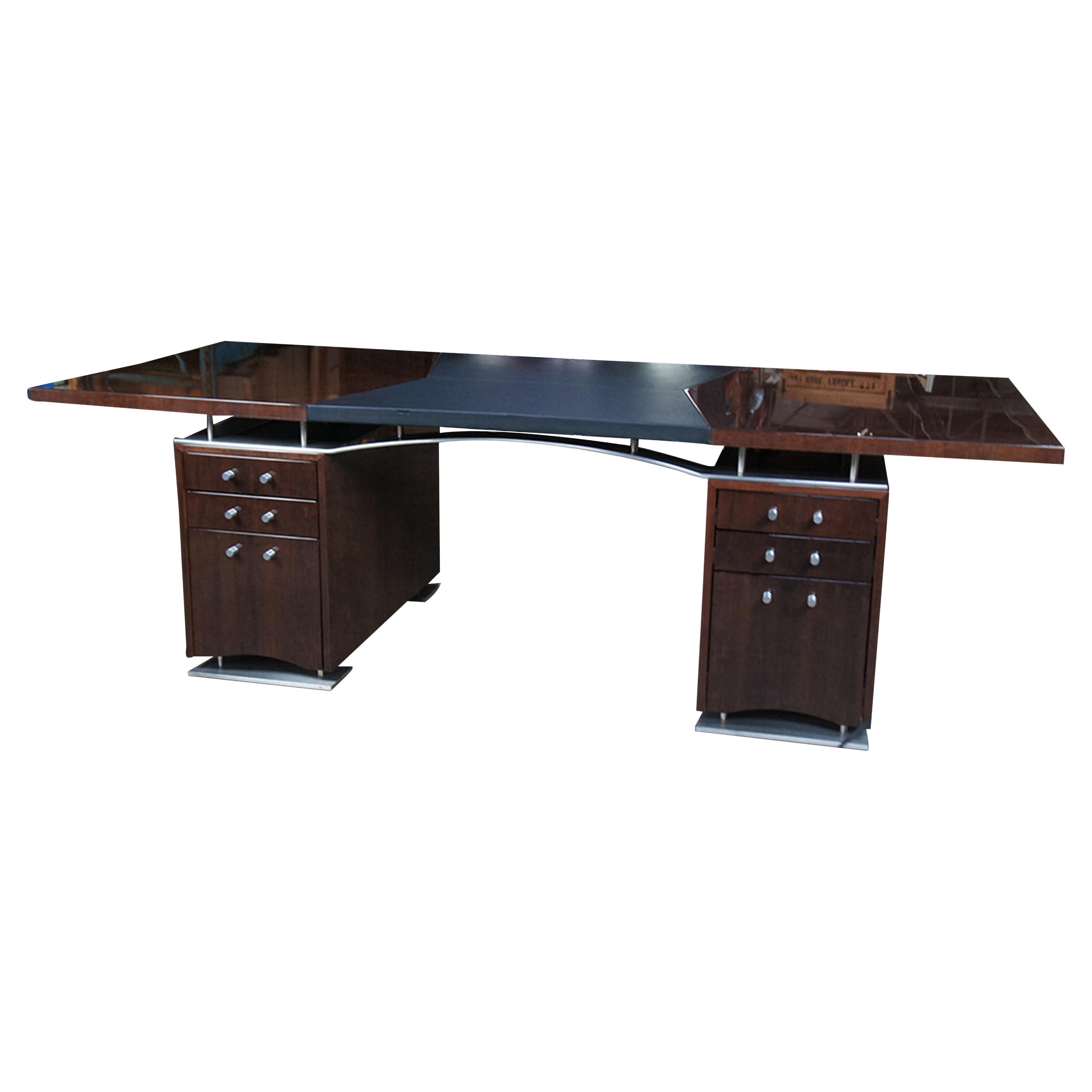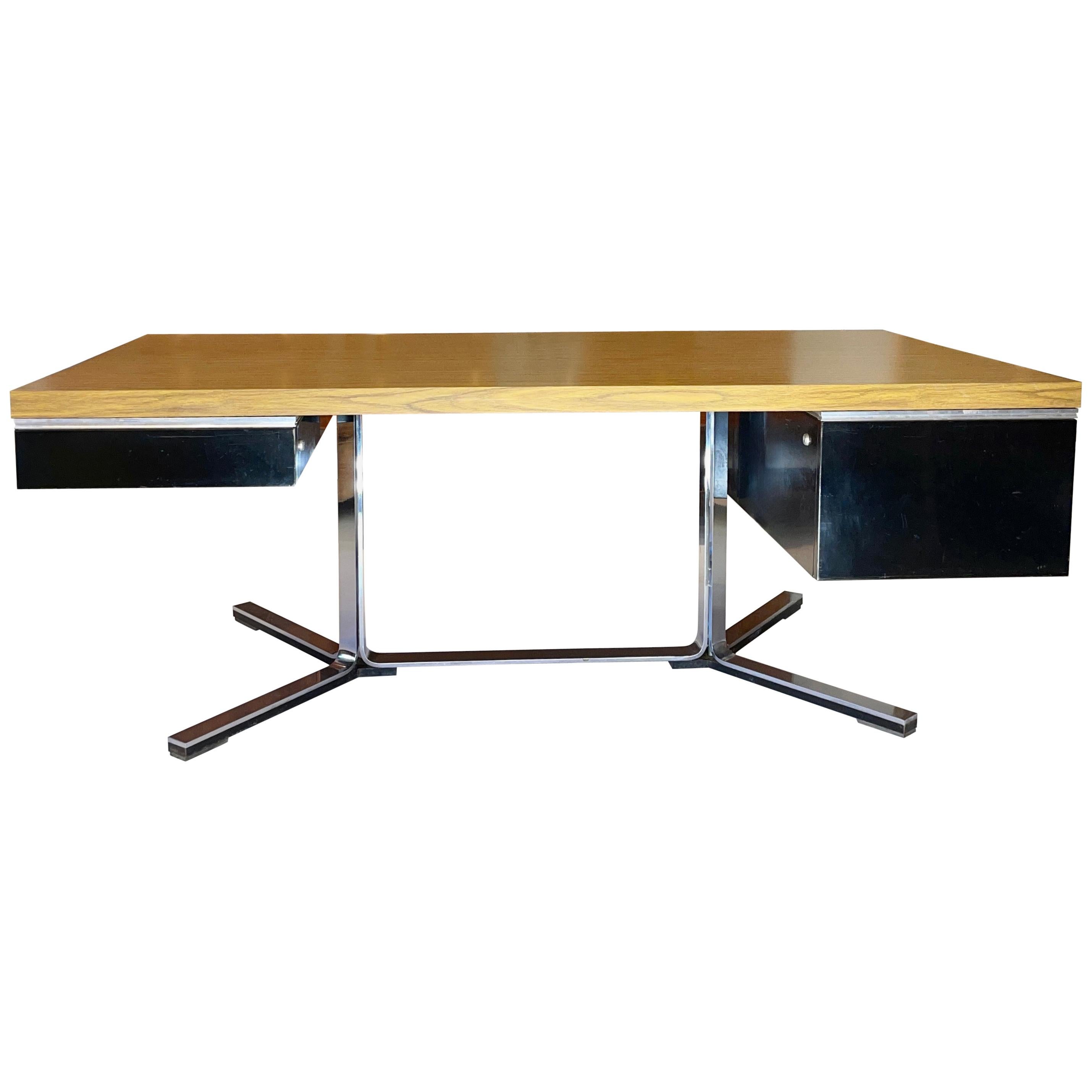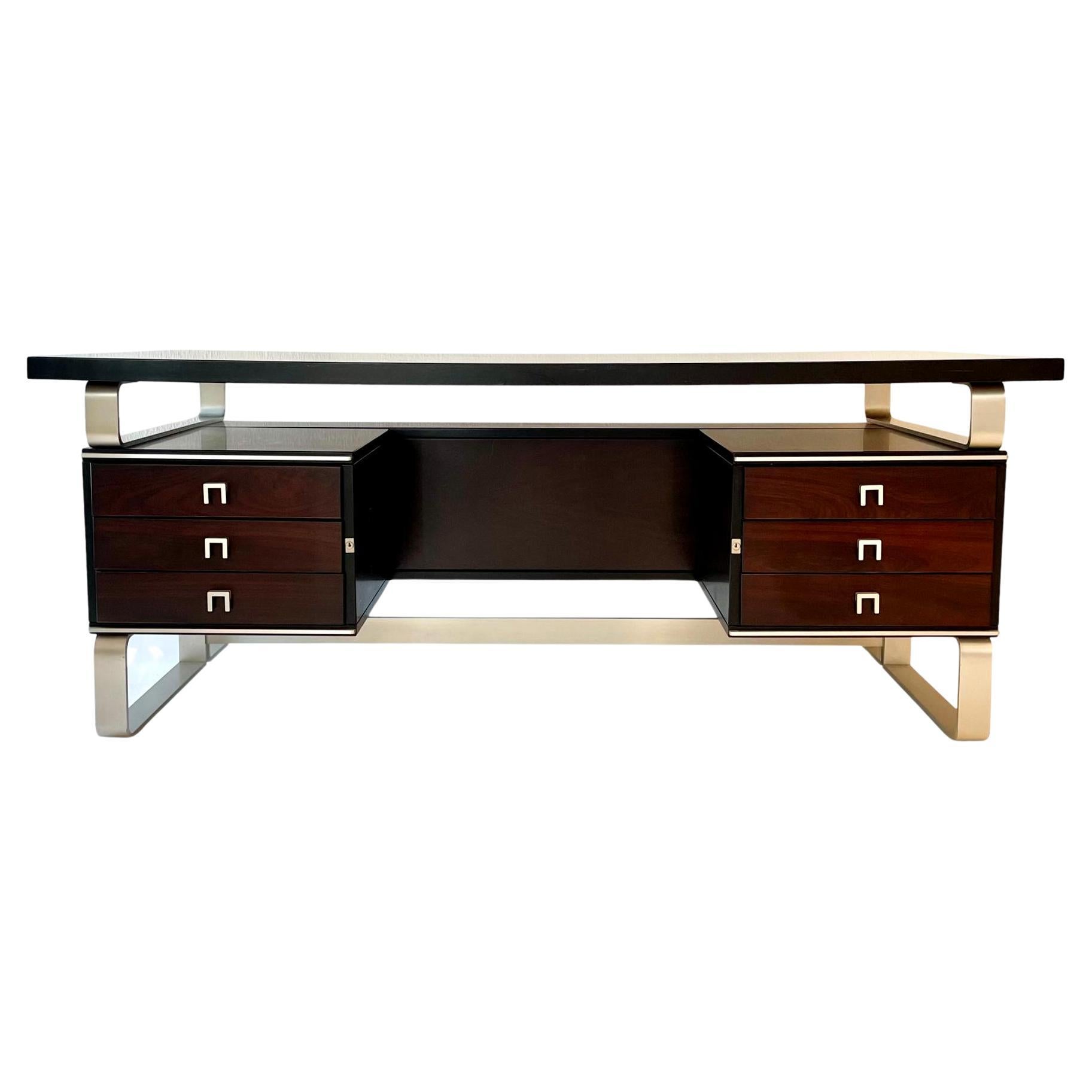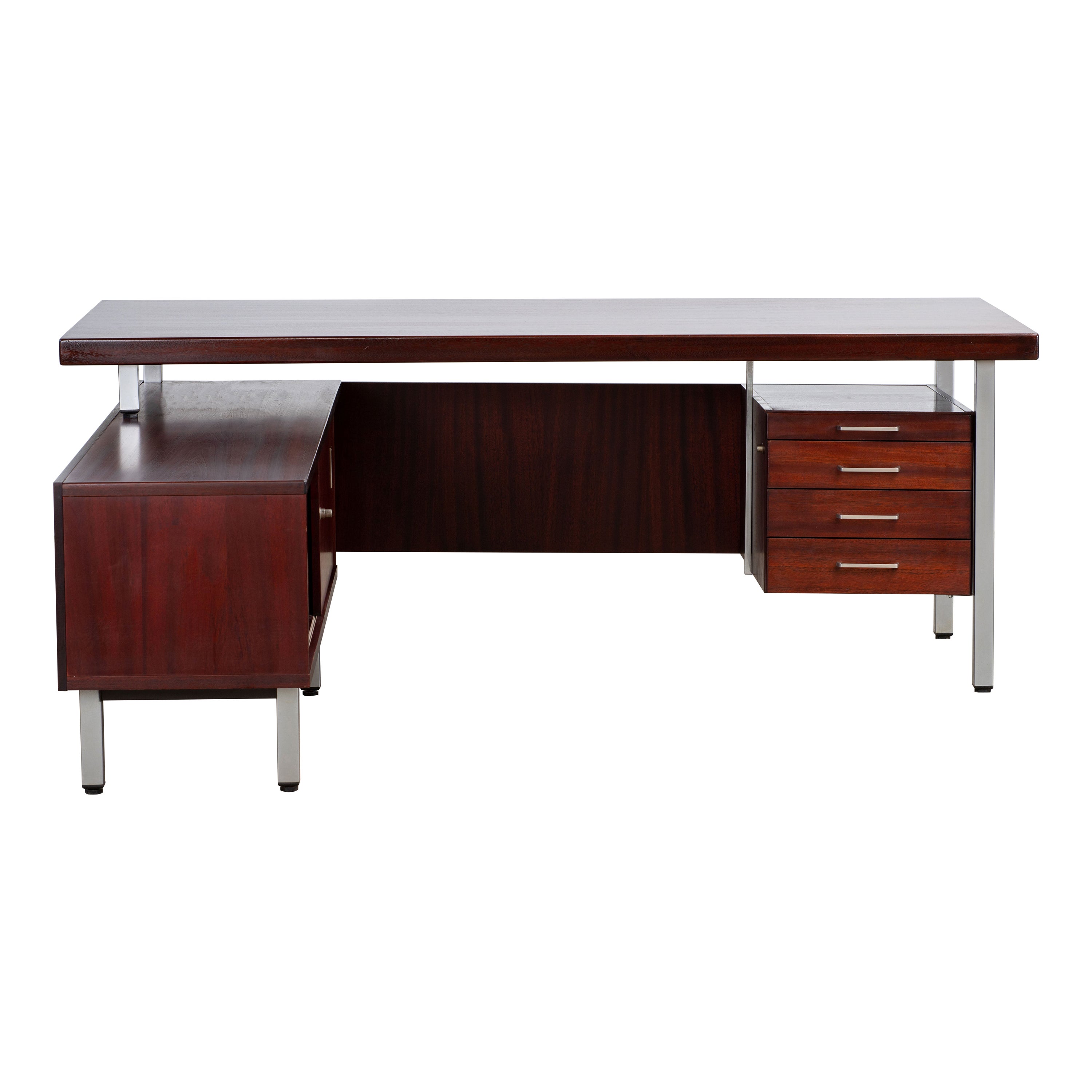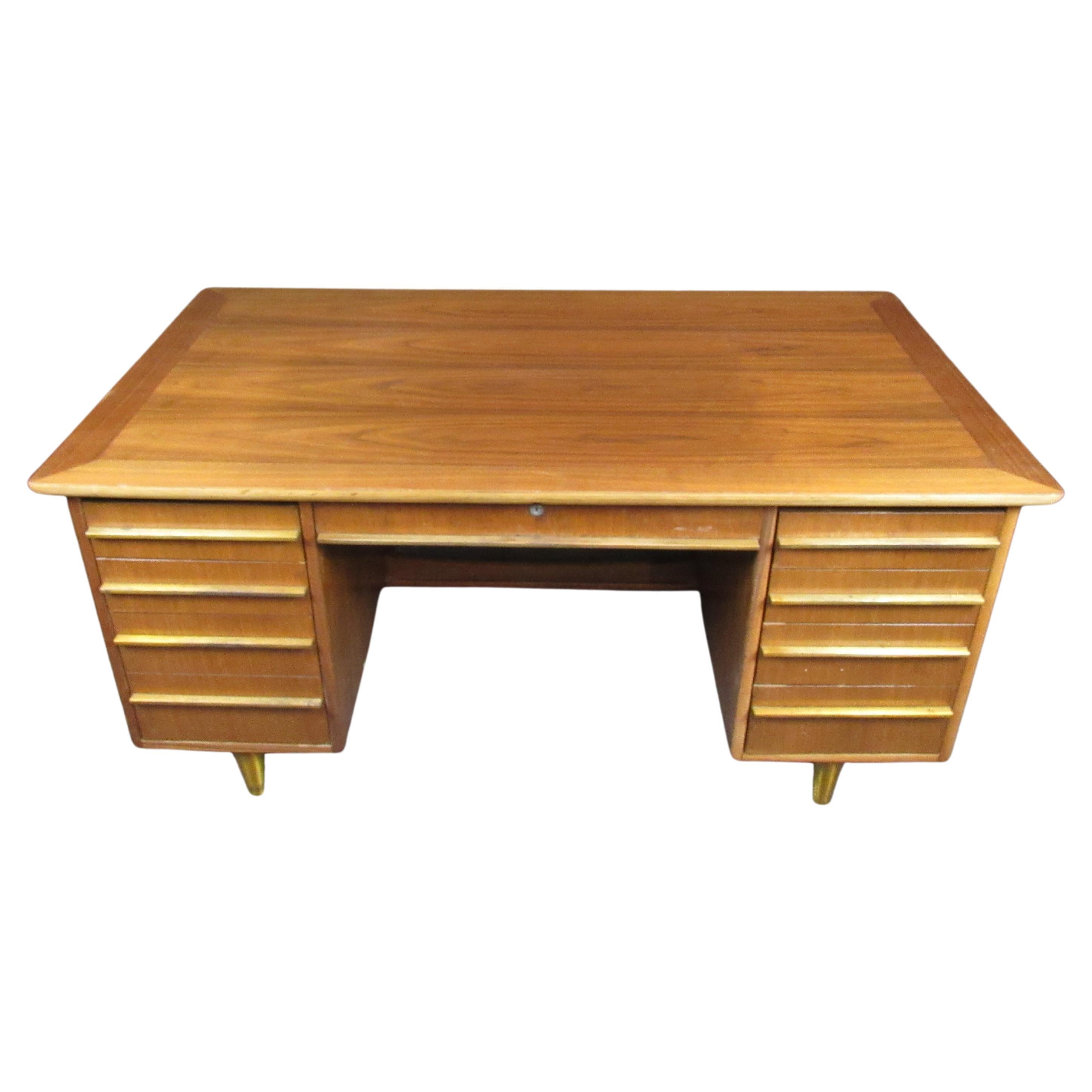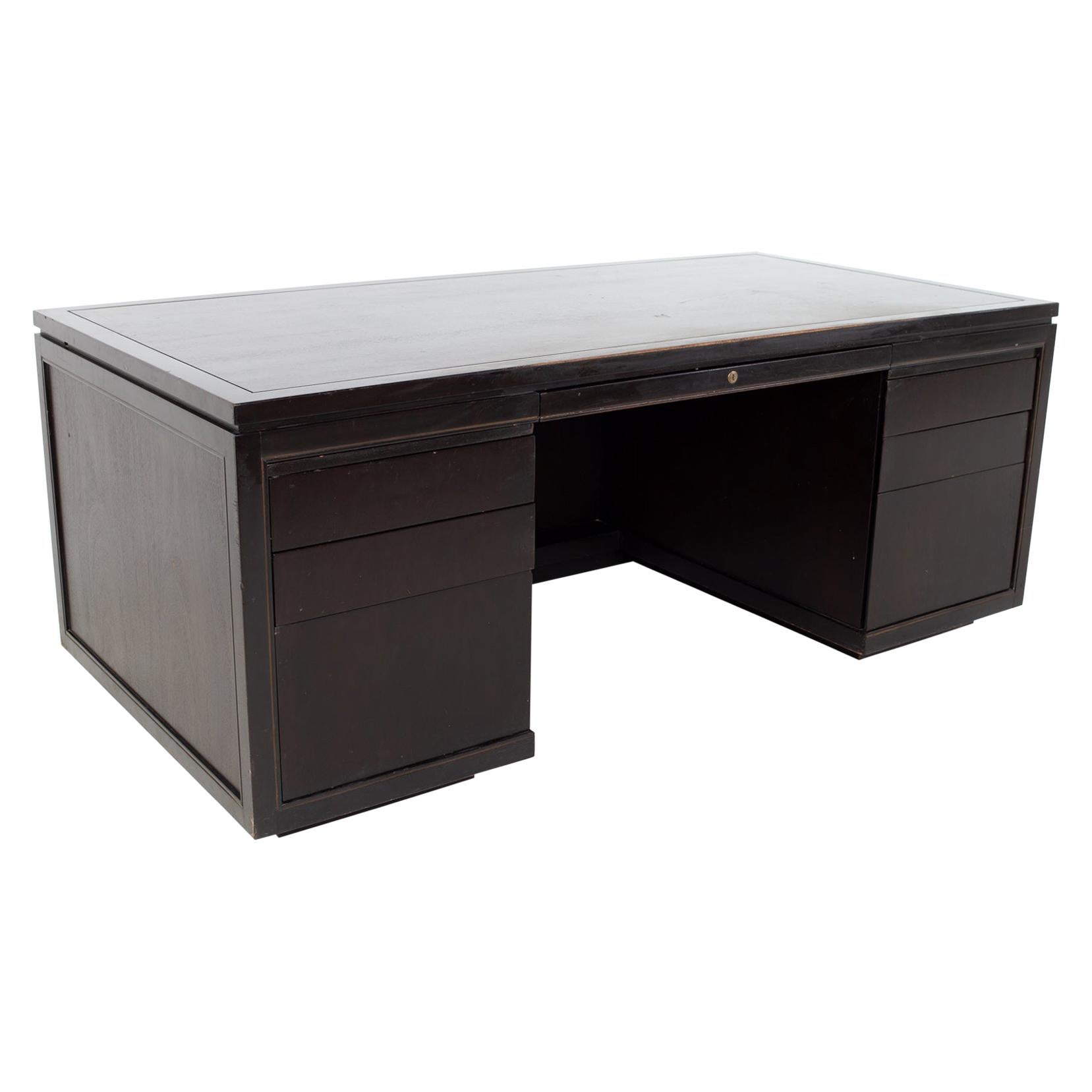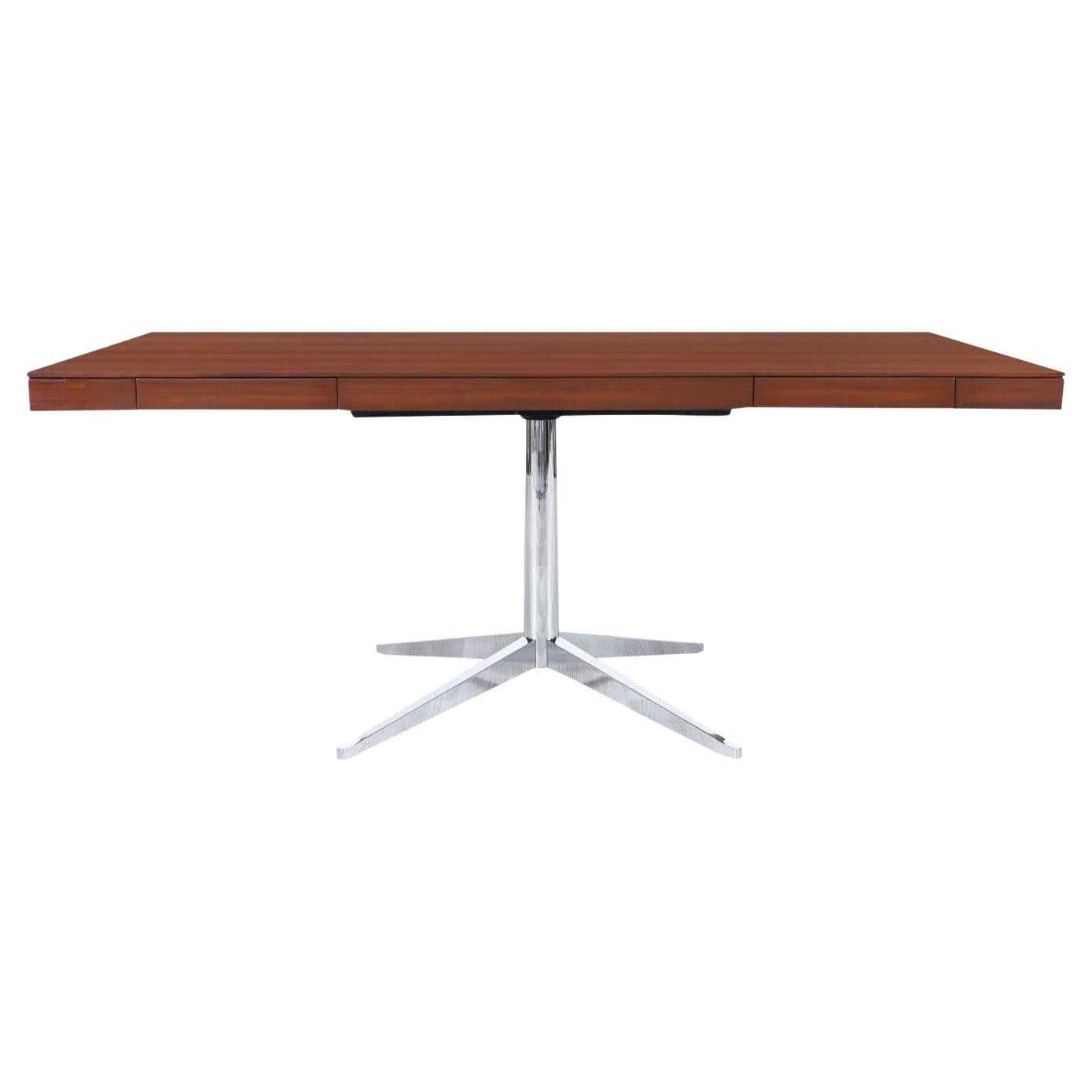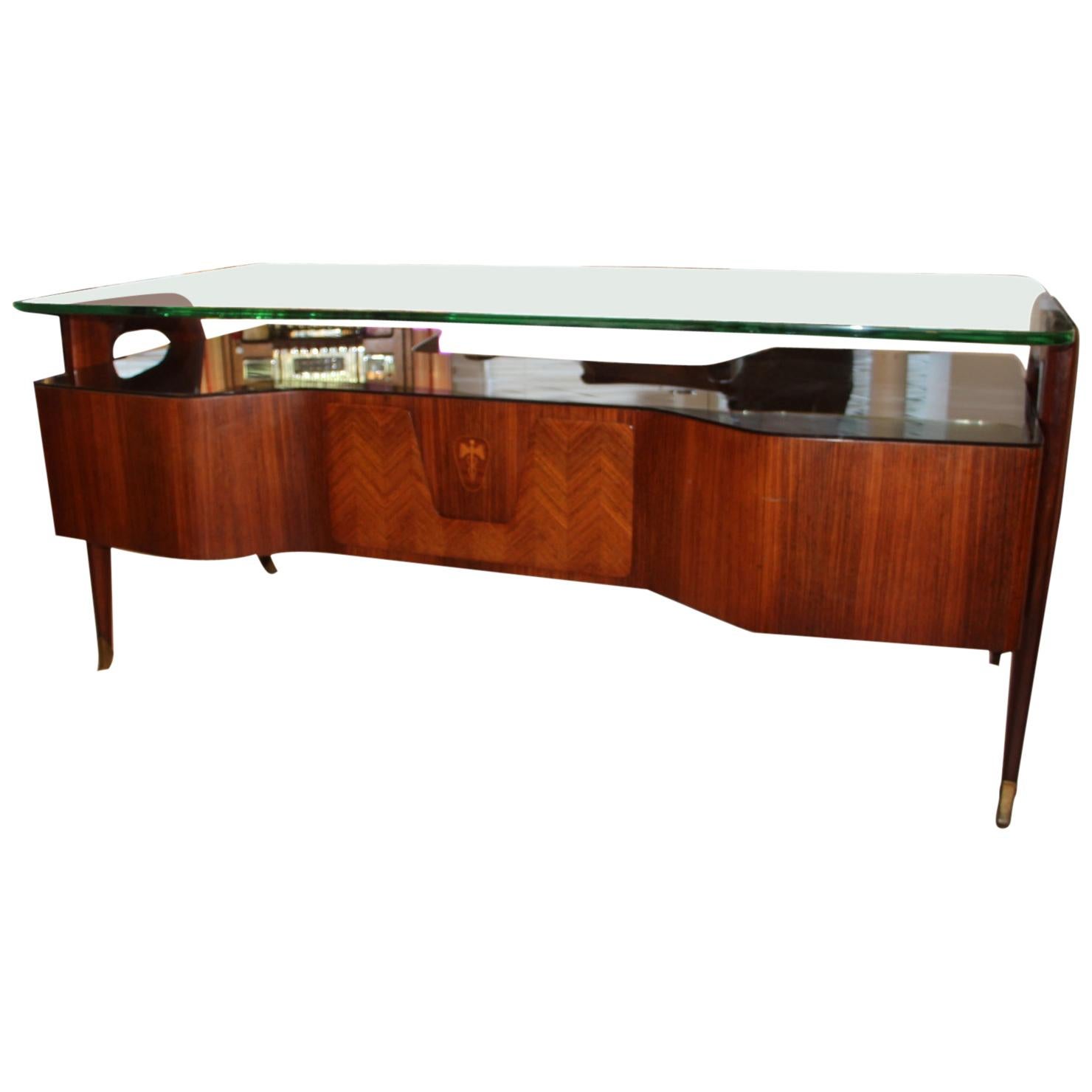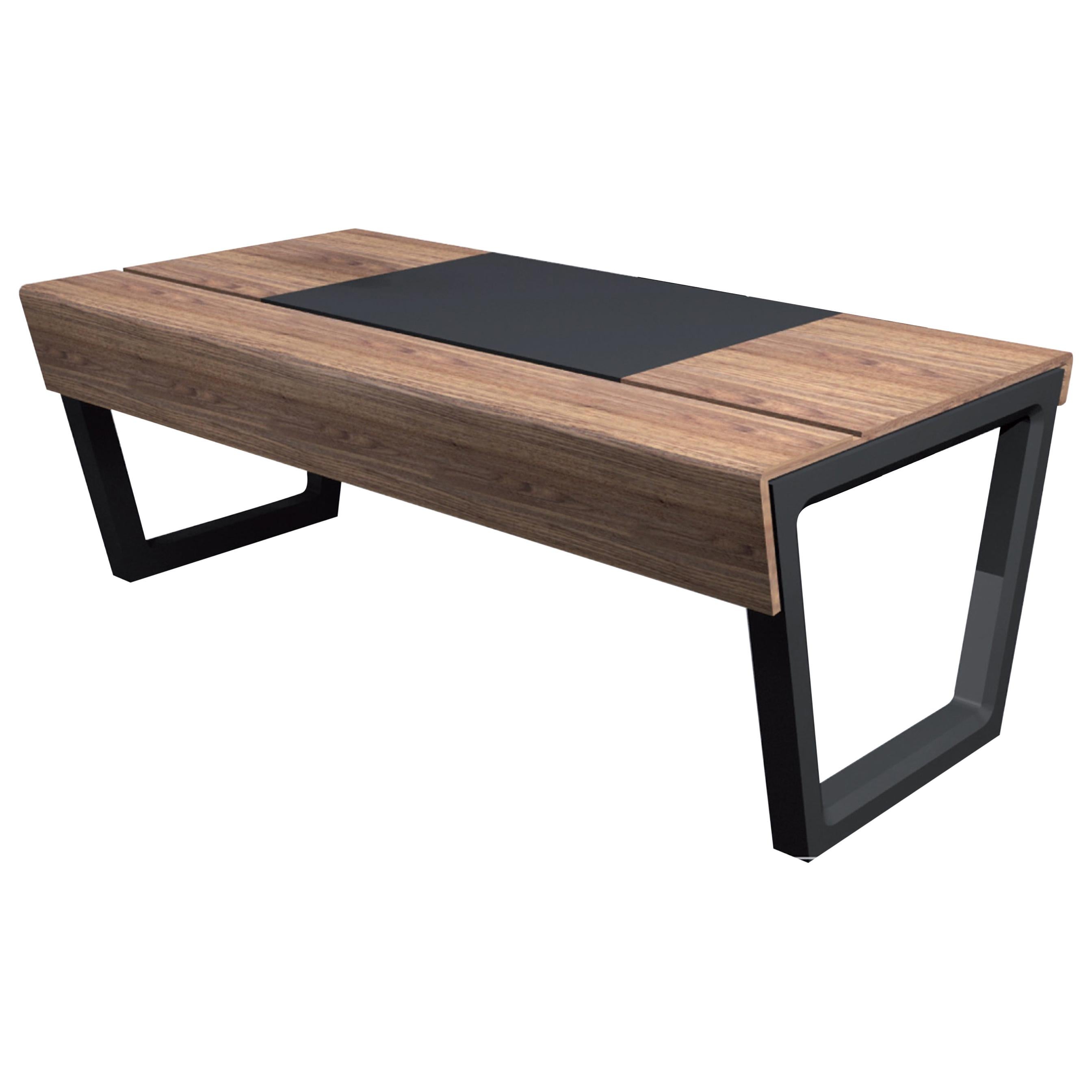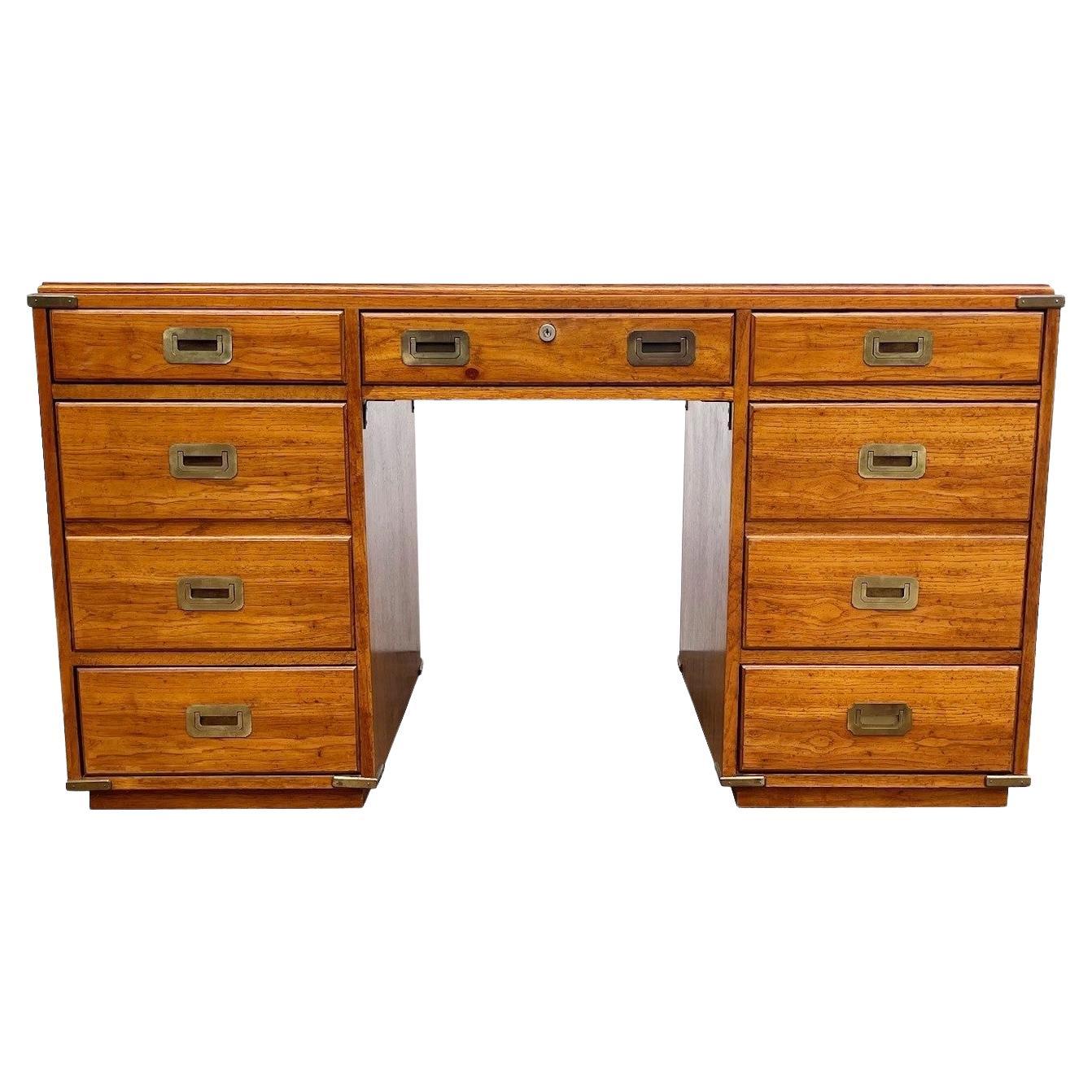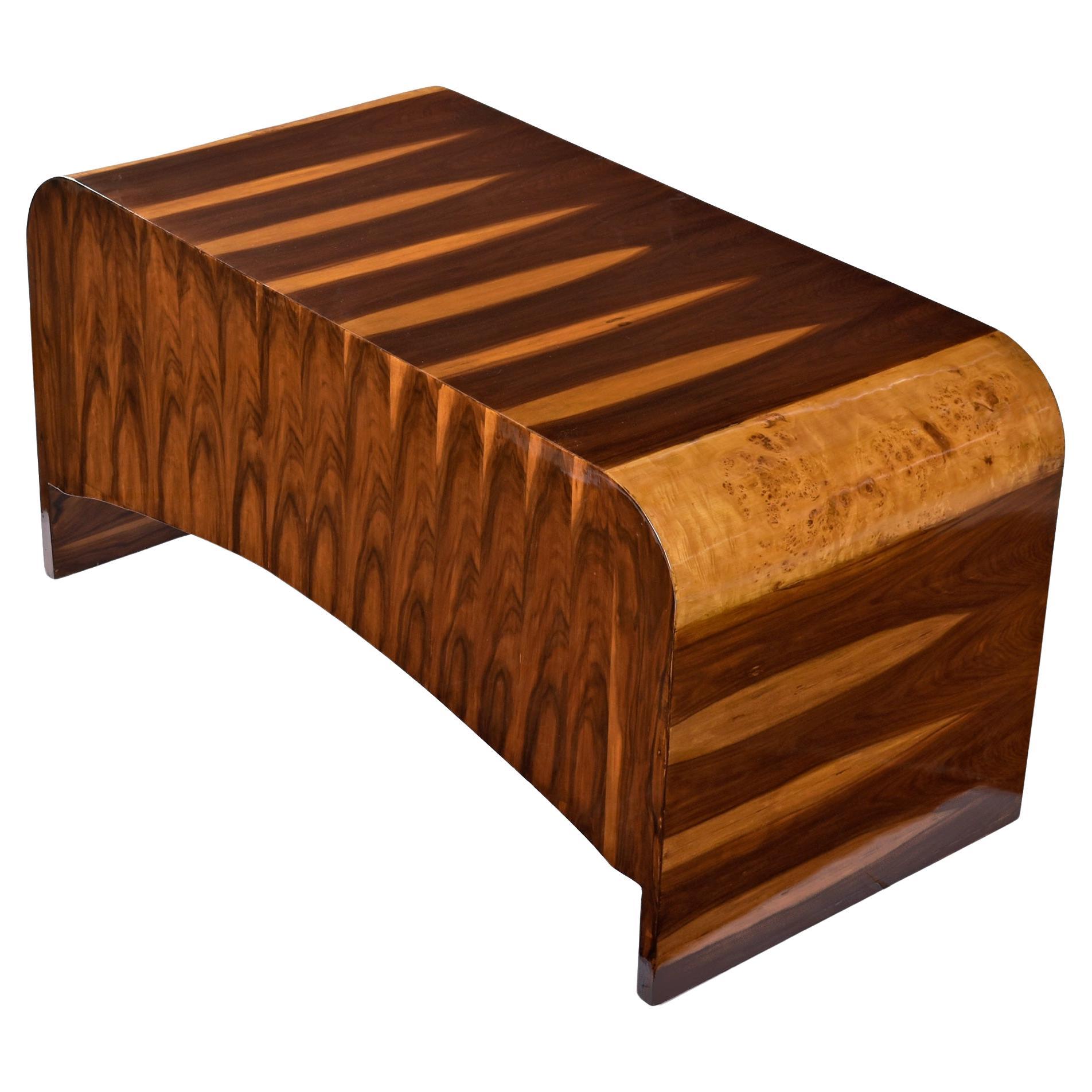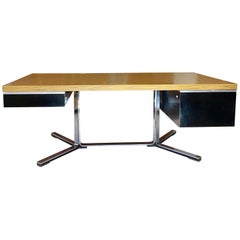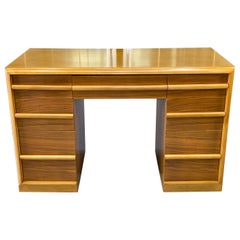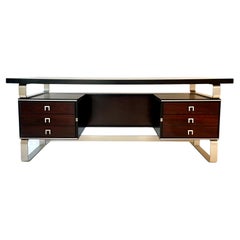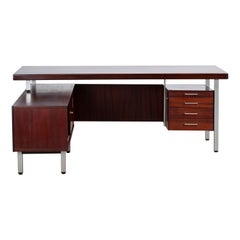
Dakota Jackson Executive Desk
View Similar Items
Dakota Jackson Executive Desk
About the Item
- Creator:Dakota Jackson (Designer)
- Dimensions:Height: 29 in (73.66 cm)Width: 84 in (213.36 cm)Depth: 43 in (109.22 cm)
- Style:Modern (Of the Period)
- Place of Origin:
- Period:
- Date of Manufacture:Late 20th century
- Condition:There are two chips to one of the side slabs as well as several scratches to the drawer fronts and nicks to the top front edge.
- Seller Location:Hanover, MA
- Reference Number:1stDibs: LU8866833059
Dakota Jackson
Today, Dakota Jackson’s luxury chairs, sofas, tables and other pieces are known for their stylish and expressive forms, so it’s perhaps not a surprise that the American contemporary furniture designer has spent a lifetime immersed in the arts.
Born to a family of professional magicians, Jackson was raised in a household that had a flair for the dramatic. A young Dakota moved to Manhattan and mingled with the bustling creative scene. There, he studied minimalist dance at multiple companies, performed with an experimental theater group and worked in special effects. His fascination with illusion and drama seeped into his creative inclinations, especially when he decided to shift his artistic energy toward furniture.
Jackson’s foray into design began in the 1970s when he got his hands dirty during the build-out of his loft apartment in New York City’s Chelsea neighborhood back when lofts weren’t quite the heavenly residences of today. He constructed his own walls and bathroom fixtures and worked with a variety of materials that included lacquered wood, leather and chrome-plated steel, crafting intriguing seating and case pieces that would later end up in museums. (His famed Library chair is part of the collection at Cooper Hewitt, Smithsonian Design Museum.)
Jackson’s work became so well known throughout the buzzing art scene that he garnered the attention of reputable antique dealers who enlisted him to restore their own pieces of furniture. In 1974, Yoko Ono became a client. She commissioned Jackson to design a desk for John Lennon’s birthday. After he finished the former Beatle’s custom piece — an unconventional Art Deco–style writing desk that mirrored a Chinese puzzle box with secret compartments and hidden drawers — celebrities flocked to Jackson like bees to honey, and his name became synonymous with immaculate craftsmanship as well as the era’s radical American Art Furniture movement, which drew on Surrealism, Pop art and other traditions.
Even Belgian fashion designer Diane von Furstenberg asked Jackson to create the now-famous Eclipse bed, a sensual, striking structure framed in glossy cherrywood and upholstered in satin. In 1978, the lifelong arts lover paired a piano factory with his furniture manufacturing company and collaborated with Steinway & Sons on the design of several limited-edition pianos over the years. Today, Dakota Jackson, Inc., counts massive corporations among his clients and continues to design new collections.
Find a collection of Dakota Jackson furniture on 1stDibs.
- 1968 Executive DeskBy Warren PlatnerLocated in Hanover, MAExecutive desk formerly belonging to noted architect George M. Notter, (1933–2007) of the Boston firm Anderson Notter Finegold (now known as Finegold Alexander Architects). Current institutional memory at the firm suggests it was a special order from Herman Miller for the then new New York offices of MGM, however Herman Miller's archivist was unable to confirm. Styling, particularly the distinctive slim milled aluminum tracks through which the entire drawer carriage glides is clearly similar to Warren Platner's designs for Lehigh-Leopold which were then among the most costly of executive office furnishings. The bent flat bar chromed steel base with its distinctive pigeon toe splay is somewhat similar to a table base in Stow Davis' Electa Series, designed by Alexis Yermakov circa 1971. Walnut laminate top is very clean with no issues. One one corner edge shows a small separation. The only identifying markings are within the milled aluminum channel: G.P. F.I. 2 And the date Dec. 20, 1968. See image 18. Between the rectangular laminate top and the chrome base is a heavy blackened steel plate. Underneath the bent chrome pigeon toe feet are bars of a thick phenolic material which act as floor protector. We can have keys made to fit the two locking drawers. Tim Anderson...Category
Vintage 1960s American Mid-Century Modern Desks
MaterialsAluminum, Steel, Chrome
$6,500 - Dakota Jackson "Cuba" ConsoleBy Dakota JacksonLocated in Hanover, MACustom designed console table by Dakota Jackson.Category
20th Century American Console Tables
- T. H. Robsjohn-Gibbings Kneehole Desk for WiddicombBy T.H. Robsjohn-Gibbings, Widdicomb Furniture Co.Located in Hanover, MAAmerican Classical modern kneehole desk designed by Robsjohn-Gibbings for Widdicomb Furniture Co. in figured walnut with contrasting maple moldings. Original label in center drawer. ...Category
Vintage 1950s American Mid-Century Modern Desks
MaterialsMaple, Walnut
- Rare Harvey Probber Brass and Mahogany DeskBy Harvey ProbberLocated in Hanover, MAHarvey Probber mahogany writing desk with white laminate top with solid brass tubular legs and solid brass flat bar stretchers. Left side oriented three drawer case with original ...Category
Vintage 1950s American Mid-Century Modern Desks
MaterialsBrass
- Studio Craft East Indian Satinwood Desk by Gregg LiptonBy Gregg LiptonLocated in Hanover, MASpectacular tour de force art deco style desk custom made by Cumberland, Maine studio furniture maker, Gregg Lipton. Inspired by Émile-Jacques Ruhlmann’s Soussa desk. Executed with...Category
Late 20th Century American Art Deco Desks and Writing Tables
MaterialsSatinwood
- "Big-Superbig" Desk Suite by Guido Faleschini for Mariani Via Pace CollectionBy i4 Mariani, Guido Faleschini, Pace CollectionLocated in Hanover, MAStylish and high quality executive office ensemble produced in 1976 by i4Mariani Italy, designed by architect Guido Faleschini and retailed in the USA through Pace Collection. The...Category
Vintage 1970s Italian Post-Modern Desks and Writing Tables
MaterialsChrome
- Dakota Jackson French Art Deco Postmodern Mahogany Executive Partners Desk 96"By Dakota JacksonLocated in Dayton, OHVintage Dakota Jackson post modern Art Deco style executive partners desk featuring mahogany with leather insert and stainless steel frame. A V-Shape pattern veneer top with Black Leather inset. 2 pedestal cabinets below: each with 2 standard drawers and 1 file drawer, front and back. Polished Stainless Steel drawer pulls, post, floor plates, and arced trestle supporting desktop. DJ Chelsea Black Leather, Polished Polyresin finish. Dakota Jackson (born August 24, 1949) is an American furniture designer known for his eponymous furniture brand, Dakota Jackson, Inc.,[1] his early avant-garde works involving moving parts or hidden compartments,[2][3] and his collaborations with the Steinway & Sons piano company.[1] Jackson helped establish the art furniture movement in 1970s SoHo,[4][5] later becoming a celebrity designer in the 1980s.[6][7][8] His background in the world of stage magic helped him get his first commissions and is often cited as the source of his point-of-view.[6][9] Early life Dakota Jackson was born on August 24, 1949, and grew up in the Rego Park neighborhood of Queens, New York. Stage Magic Jackson's father, Jack Malon, was a professional magician.[10] Mr. Malon learned the trade from his own father, who studied stage magic in early 20th century Poland.[1] Jackson began studying magic at a young age and sometimes performed with his father.[11] Jackson's name, in fact, grew out of a road trip to Fargo, North Dakota.[11] Throughout his adolescence and into his early 20s, Jackson immersed himself in the world of magic.[2] In 1963, Jackson began to perform in talent shows at his junior high school, William Cowper JHS 73 (which is known today as The Frank Sansivieri Intermediate School),[12] and at children's birthday parties.[13] Jackson also began to build his own props, including large boxes for sawing a woman in half and small boxes from which doves would emerge in full flight.[11] Jackson acknowledges the importance of these early experiences with magic to his later career as a furniture designer: "The demands of performance taught me how to discipline myself to achieve aesthetic ends."[1][2][14] After Jackson graduated from Forest Hills High School in 1967, he continued performing as a magician, working in art galleries, night clubs, touring in the Catskills, and giving private performances at society events.[2][13][15] When he was 17, Jackson had studied with magician Jack London to learn the dangerous bullet catch trick.[16] "What appealed to me was the notion of doing things that appeared miraculous" Jackson once recalled.[6] "I was interested in spiritualism. I was interested in things like bullet catching, things that really challenged individual sensibilities, that were frightening, on the edge."[2] He didn't find the opportunity to perform the trick publicly until a decade later at Jackson's final professional performance as a magician.[1] It was documented in Andy Warhol's Interview (magazine), in a story titled "Dakota Jackson bites the bullet."[1][16] Jackson admits that he sometimes tires of references to his magician background, although he acknowledges it as an important part of his history.[2] The Downtown Arts Scene In the late 1960s, Jackson moved into a loft on 28th Street in Chelsea.[1][17] Jackson became part of the Downtown scene, a community of "artists, dancers, performers, and musicians" who moved to the neighborhood for the cheap rent and social life.[1][8][17][18] In October 1970, Jackson performed with the Japanese group Tokyo Kid Brothers at New York's La MaMa Experimental Theatre Club (also known as Café La MaMa) in a rock musical production called "Coney Island Play" ("Konī airando purē).[19] The show explored themes of cross-cultural communication and understanding[19] and was a follow up to the group's debut performance of "The Golden Bat" at La MaMa earlier that summer.[20][21][22] Jackson played the part of a "clever conjurer."[19] Over the next few years, Jackson became interested in minimalist dance and performed in the dance companies of Laura Dean and Trisha Brown.[2][15][23] Jackson credits his exposure to minimalism and minimalist dance in particular as having had a strong influence on his approach to design; in 1989, Jackson told the Los Angeles Times: For me the essential fineness of a design is in the idea, not the object itself ... In minimalism, the object is pared down to its basic meaning by stripping away all the excrescence ... —those elements that do not contribute to the pure idea.[24] Design career In the early 1970s, as he experimented with performance and dance, Jackson began branching out as a special effects consultant to other magicians, film producers, and musicians[2][23] such as Donna Summer.[6][9] The loft also gave Jackson an opportunity to apply his creativity and building skills: "These were times when lofts were not ... luxury condominiums. These were tough, tough raw spaces ... and we artists, bohemians, creative people, we created our environment. So I had to build".[17][25] Recognizing his skills as a builder, Jackson decided to shift away from performance and become a full-time maker.[1][15][17] He began making a variety of objects, including furnishings for other artists and magic boxes with hidden compartments for art collectors and galleries.[17][24] Jackson's social connections helped spread word about his work[15] and this led to his first commissions.[1] Early Commissions Desk for John Lennon by Dakota Jackson In 1974, Jackson's career as a designer began when Yoko Ono asked him to build a desk with hidden compartments for husband John Lennon.[26] "She wanted to make a piece of furniture that would be a mystical object; that would be like a Chinese puzzle," Jackson recalled in a 1986 interview published in the Chicago Tribune.[6] The result was a small cubed-shaped writing table with rounded corners reminiscent of Art Deco era style.[15] Touching secret pressure points opened the desk's compartments.[23] This commission helped build Jackson's reputation and allowed him to merge his experience as a magician and performer with his developing interest in furniture.[27] In 1978, a bed designed for fashion designer Diane von Furstenberg garnered Jackson even more notoriety.[8][10][28] [29] Called "The Eclipse", the bed was described in The New Yorker as "large, astounding, sumptuous, with sunbursts of cherry wood and quilted ivory satin at head and foot."[10] A lighting system positioned behind the headboard switched on automatically at sunset and spread out rays of light "like an aurora borealis,"[2][17] which grew brighter and brighter until turning off at 2 am.[23][30] Commissions like these continued to come in[8] and Jackson soon became known as a designer to the rich and famous.[30] Some of his other clients from this period included songwriter Peter Allen, Saturday Night Live creator and producer Lorne Michaels, Rolling Stone publisher Jann Wenner, and soap opera actress Christine Jones.[8] The American Art Furniture Movement and the Industrial Style In the late 1970s, Jackson was among a small group of artists and artisans producing and exhibiting hand-made furniture in New York.[5][31] Jackson and his peers were part of the "American Art Furniture Movement," a group sometimes called the "Art et Industrie Movement,"[32] named after the leading art furniture gallery of the era,[32] Art et Industrie, founded by Rick Kaufmann in 1976.[33] In a 1984 Town & Country article titled "Art You Can Sit On," Kaufmann said he created the gallery to "serve as a locus to the public for artists and designers creating new decorative arts."[31] The works on display were "radical objects" that drew from a number of fine art traditions, including "Pop, Surrealism, Pointillism and Dada [which were] "thrown together with the severe lines of the Bauhaus and the Russian avant-garde, mixed with Mondrian's color and filtered through a video sensibility—all to create a new statement."[31] The article described Jackson as a "ten-year veteran of the genre" and pointed to the "clean forms and quiet colors" of his furniture.[4] Jackson showed a variety of industrial-looking lacquer, metal, and glass works at Art et Industrie, including his Standing Bar (also known as the Modern Bar),[33] a lacquered cabinet that Jackson designed in 1978 for his wife (then-girlfriend) RoseLee Goldberg.[13] Other works from this period include the T-Bird Desk, Self-Winding Cocktail Table, and the Saturn Stool...Category
Late 20th Century Art Deco Desks and Writing Tables
MaterialsStainless Steel
- Executive Abbondi Desk, 1970s ItalyLocated in Los Angeles, CAStunning Italian executive desk in a dark Rosewood. Three pull-out drawers flank each side. Lockable drawers with original locks. Solid aluminum frame with unusual, rounded corners o...Category
Vintage 1970s Italian Mid-Century Modern Desks
MaterialsAluminum
- Executive Desk, Corner Desk in Mahogany, Germany, 1970'sBy Johannes Andersen, Arne VodderLocated in Wiesbaden, DEBeautifully designed writing desk in teak. With a very distinct design this desks every wood surface has been given specific angles such as the tabletop, the unit with drawers as wel...Category
Mid-20th Century German Scandinavian Modern Desks
MaterialsMetal
- American Walnut & Brass Vintage Executive DeskLocated in Brooklyn, NYRevive the hustle and bustle of the mid-century American workplace with this jaw-dropping walnut executive desk. Boasting a newly refinished walnut top measuring over 14 square feet ...Category
Mid-20th Century American Mid-Century Modern Desks and Writing Tables
MaterialsBrass
$1,960 Sale Price30% Off - Dunbar Contract Division Mid Century Executive DeskBy Dunbar FurnitureLocated in Countryside, ILDunbar contract division Mid Century executive desk Desk measures: 72 wide x 36 deep x 28.5 inches high All pieces of furniture ca...Category
Vintage 1970s American Mid-Century Modern Desks
MaterialsPlexiglass, Wood
- Vintage Walnut Executive Desk by Florence KnollBy Knoll, Florence KnollLocated in North Hollywood, CAAmazing vintage executive desk designed by architect and furniture designer Florence Knoll in the United States, circa 1960s. This iconic design...Category
Vintage 1960s American Mid-Century Modern Desks
MaterialsSteel, Chrome
